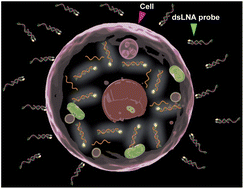Detection of mRNA in living cells by double-stranded locked nucleic acid probes
Abstract
Double-stranded probes are homogeneous biosensors for rapid detection of specific

* Corresponding authors
a
Department of Aerospace and Mechanical Engineering, The University of Arizona, Tucson, USA
E-mail:
pak@email.arizona.edu
Fax: +1-520-621-8191
Tel: +1-520-626-2215
b Biomedical Engineering Interdisciplinary Program, The University of Arizona, Tucson, USA
c Mechanical and Aerospace Engineering, University of California, Los Angeles, Los Angeles, USA
d Department of Pathology and Laboratory Medicine, UCLA, Los Angeles, CA, USA
e Department of Pharmacology and Toxicology, The University of Arizona, Tucson, USA
f BIO5 Institute, The University of Arizona, Tucson, USA
Double-stranded probes are homogeneous biosensors for rapid detection of specific

 Please wait while we load your content...
Something went wrong. Try again?
Please wait while we load your content...
Something went wrong. Try again?
R. Riahi, Z. Dean, T. Wu, M. A. Teitell, P. Chiou, D. D. Zhang and P. K. Wong, Analyst, 2013, 138, 4777 DOI: 10.1039/C3AN00722G
To request permission to reproduce material from this article, please go to the Copyright Clearance Center request page.
If you are an author contributing to an RSC publication, you do not need to request permission provided correct acknowledgement is given.
If you are the author of this article, you do not need to request permission to reproduce figures and diagrams provided correct acknowledgement is given. If you want to reproduce the whole article in a third-party publication (excluding your thesis/dissertation for which permission is not required) please go to the Copyright Clearance Center request page.
Read more about how to correctly acknowledge RSC content.
 Fetching data from CrossRef.
Fetching data from CrossRef.
This may take some time to load.
Loading related content
